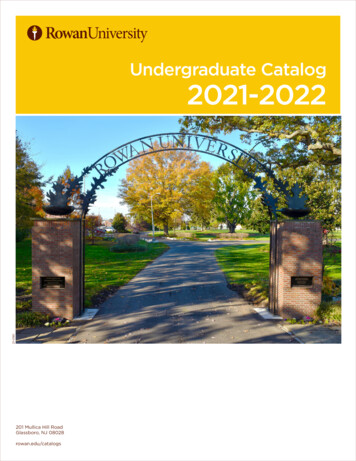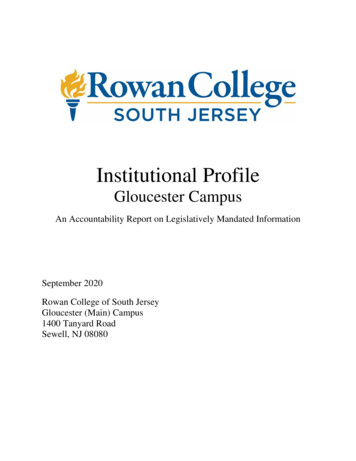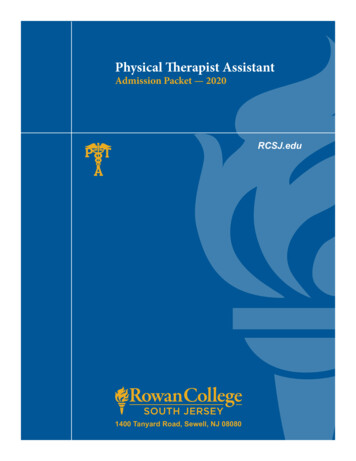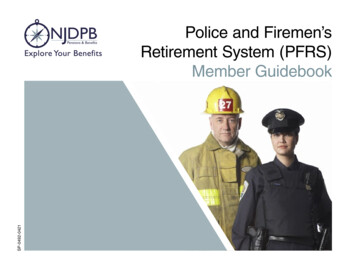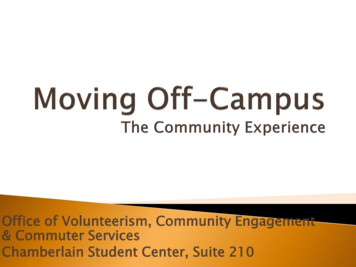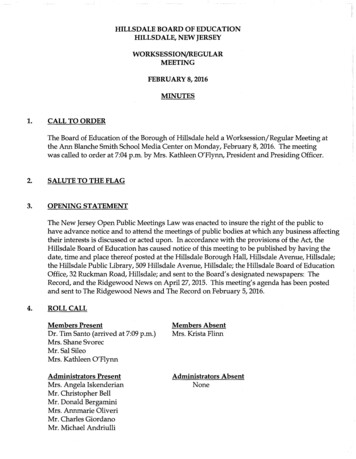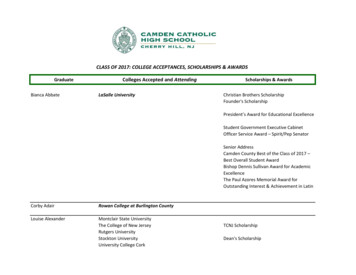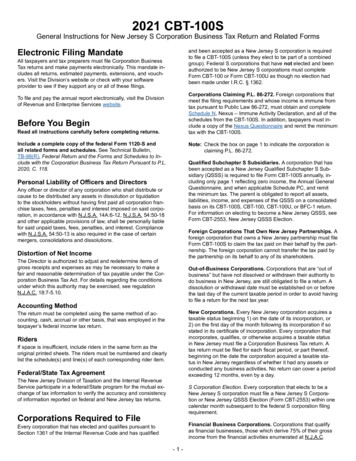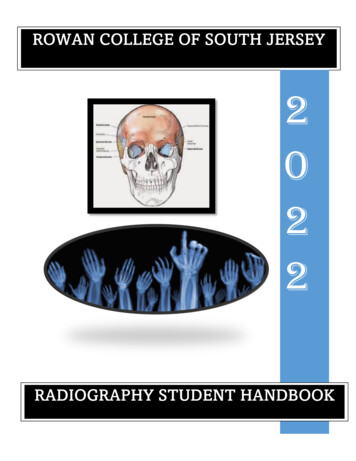
Transcription
ROWAN COLLEGE OF SOUTH JERSEY2022RADIOGRAPHY STUDENT HANDBOOK
The Rowan College of South Jersey (RCSJ) Radiography Program has dual educationresponsibilities and requirements for successful completion of the program. This is asupplemental student handbook for policies and procedures that are specific to theRadiography Program.Refer to the program website via www.rcsj.edu for additional informationDue to the unique academic-clinical requirements of the Program, students areresponsible for all Policies and procedures contained in the:RCSJ College CatalogRCSJ Student HandbookRCSJ Radiography Program HandbookPolicies and Procedures of the assigned Clinical Education CenterPROGRAM ACCREDITATIONThe program is accredited by the Joint Review Committee on Education inRadiologic Technology (JRCERT) and the Department of EnvironmentalProtection Bureau of Radiation Protection for the State of New Jersey (NJDEP).RCSJ adheres to the Standards for an Accredited Educational Program for theRadiographer, updated most currently for 2021. A copy of the Standards isavailable for review on the program’s website. A non-compliance policy isincluded as an Appendix in this Handbook.STATEMENT OF NON-DISCRIMINATORY POLICYRCSJ endorses the concepts of nondiscrimination and equal opportunity for all, regardlessof color, race, religion, sex, national origin, handicap, age, place of birth, marital status, orliability for military service. The college follows the guidelines of Section 504 of the 1973Federal Rehabilitation Act, which mandates equal access to education for disabled students.Campus Coordinator for Title IX and 504 activities is Rosemarie Fiscus, Executive Directorof Human Resources, Administration Building, (856)691-8600, extension 1235. Thisindividual is designated to coordinate the college’s efforts to comply with and carry out itsresponsibilities under Title IX, Section 504/the ADA, and the Age Discrimination Act, whichprohibit discrimination on the basis of sex, disability and age, respectively.RCSJ Radiography Program reserves the right to change the curriculum andeducational policies as considered necessary for the progressive developmentof the program.The Radiography Program Handbook was revised May 2022
TABLE OF CONTENTSWelcome . 3Essential Functions . 4Mission Statement & Program Goals . 5Program Faculty. 6Career Description . 7Curriculum . 7Academic Integrity .8Student Attendance . .8Student Guidance and Advisement Process. .9Student Grievance Procedure. 9Progression and Retention of Students . 10 Grading Policy . 10 Progression Policy . 10 Retention Policy . 10 Course and/or Program Withdraw Policy . 11 Incomplete Grades Policy . 11 Leave of Absence Policy . 11 Program Readmission Policy . 11Graduation . 12Pinning Ceremony . 12 Academic Achievement Award . 12 Clinical Excellence Award . 12 Lamba Nu Society .12American Registry of Radiologic Technologists . 13New Jersey State Licensure Requirements . 14Professional Societies . 15 New Jersey Society of Radiologic Technologists. 15 American Society of Radiologic Technologists . 15COMPETENCY-BASED CLINICAL EDUCATION MASTER PLAN . 16Philosophy of Clinical Education . 17Clinical Education and Competency Progression Plan. 17Remediation Plan . 19Student Supervision . 19 Repeat Procedure Policy . 21 Pediatric Patient Policy . 21 Contrast Media Injections Policy. 22 Mammography Policy . 22 Staff Technologist Responsibilities .22Clinical Education Flowchart . 23Clinical Competency Requirements . 24Infrequent Studies Policy . 26Coordination of Clinical Education Centers . 27Evaluation of Clinical Performance . 27Student Records in the Clinical Area . 281
Clinical Education Room Assignments . 28Code of Ethics . 29Professional Behavior and Conduct for Students . 30Critical Incidents and Immediate Dismissal .31Program Pregnancy Policy. 32NJDEP Student Pregnancy Policy . 33Health Policy. 34 Communicable Disease Policy . 34 Injuries during Clinical Education Assignment . 34Inclement Weather Policy. 35Radiation Monitoring Policy . 35Clinical Attendance / Lateness . 36 Supplemental Clinical Education Experience. 36Clinical Education Days . 37Clinical Education Hours . 37 Off-hour Rotations . 37Clinical Grades . 37Clinical Education Dress Code . 38Clinical Education Assignments . 39Reporting Allegations of Sexual Assault & Resource Referrals .40Affirmative Action Statement . 41APPENDIX Listing . 42A. Competency GoalsB. Competency Evaluation CriteriaC. JRCERT Non-Compliance PolicyD. Laboratory Competency EvaluationE. Competency Evaluation FormF. Performance Evaluation FormG. Image Evaluation FormH. Critical Incident FormI. Supplemental Clinical Education FormAcknowledgement of Clinical Education CentersAcknowledgement of Student Handbook2
WELCOME TO YOUR NEW CAREERThe faculty of the RCSJ Radiography Program welcomes you as a student radiographer. We hopethat you will find this to be a warm, friendly environment in which to learn.You are entering the field of Radiography. This will be a new world for you as it will be your firstencounter with the behind-the-scenes operation of a hospital.As a student radiographer, you will be part of a medical team working in a branch of medicine calledDiagnostic Imaging or Radiology. You will assist physicians known as Radiologists who specializein the use of X-rays and other imaging methods to diagnose and treat various injuries and diseases.You will play a vital role in a science dedicated to saving lives and alleviating human suffering.The education of radiographers is somewhat different than the education provided in other academicsettings. Part of your education will be in the classroom and the other will be practical clinicalexperience. During the next two years, you will be closely observed in the classroom and in theclinical education center. You will be working closely with staff radiographers and physicians. Uponthe successful completion of your education, you will be qualified to work in a hospital, diagnosticimaging center, physician's office, and with mobile imaging companies.We hope this handbook will help you become acquainted with the RCSJ Radiography Program. Asa student, there will be a number of expectations. You will have new responsibilities and will berequired to meet professional standards.In order to offer efficient and professional service to our patients, regulations within the ClinicalEducation Settings are necessary. These will be reviewed for you in this handbook, the collegehandbook and college catalog. All student radiographers are subject to the basic rules andregulations of the hospital, imaging department, and the school program. Rules and regulations arefound in every walk of life and to some extent are even more important in the hospital environment.The safety of patients and students is of primary importance. You must be physically andmentally able to complete the Essential Functions which are listed on the next page. Pleasereview these criteria carefully. If you have a documented disability and wish to discuss thepossibility for reasonable accommodations, please contact the Program Director prior to thestart of the program.We hope you will find your association with the faculty, radiologists, radiographers, and fellowstudents to be intellectually and professionally rewarding. We hope you will dedicate yourself to theRCSJ Radiography Program tradition of offering the "Best of Patient Care".3
Due to Joint Commission on Accreditation for Healthcare Organizations requirementsconcerning Clinical Education Settings, students are required to submit to a backgroundcheck prior to assignment to clinical sites.Admission to the program is contingent upon successful completion of the background checkand physical exam, including drug screening. Students may be subjected to random drugtesting, as deemed necessary by the clinical site, at any time while enrolled in the program.Background checks and medical forms will be shared with the clinical affiliate the student isassigned to.Essential FunctionsWhile in the clinical education center, the student radiographer must be able to:1.Have sufficient strength, motor coordination, and manual dexterity to be able to:a.b.c.2.Be capable of:a.b.c.3.Communicating verbally in an effective manner in order to explain and direct patientsas it relates to their examination.Handling stressful situations related to technical and procedural standards and patientcare situations.Providing physical and emotional support to the patient during radiographicprocedures and be able to respond with speed to situations requiring basic first aidand emergency care.Have the mental or intellectual capacity to:a.b.c.4.Transport, move, lift, or transfer patients from a wheelchair/stretcher to an x-ray tableor to a patient bed.Move, adjust, and manipulate a variety of radiographic equipment (including thephysical transportation of portable x-ray machines) in order to arrange the equipmentand align it properly with respect to the patient and the image receptor according toestablished procedure and standards of speed and accuracy.Physically place patients in the proper positions for the examination according toestablished procedures and standards of speed and accuracy.Calculate and select the proper technical exposure factors according to the individualneeds of the patient and the requirements of the procedure with speed and accuracy.View and evaluate the recorded images or radiographs for the purposes of identifyingproper patient position, accurate procedural sequencing, proper radiographicexposure, and other pertinent technical qualities.Properly use computer systems and other technology within the radiographydepartment.Must possess the sensory factors necessary to provide optimal patient care. These sensesinclude, but are not limited to, hearing (with or without aids), vision (with or without aids)including color and depth perception, clarity of speech, and tactile sensory perception.If you feel you will be unable to achieve any of these goals, please notify the Clinical Coordinator and/orProgram Director prior to the first day of school.4
THE MISSION OF THE RADIOGRAPHY PROGRAMTo provide competent entry-level technologists through a high quality, career-oriented education inradiography.GOALS OF THE RADIOGRAPHY PROGRAM1.Students will be competent when performing radiographic procedures.Student Learning Outcomes:1. Students will provide effective patient care.2. Students will accurately position patients for a variety of exams.2.Students will demonstrate effective communication.Student Learning Outcomes:1. Students will display an understanding of the principles of effective communicationin the academic setting.2. Students will communicate effectively in the clinical education sites.3.Students will demonstrate problem solving / critical thinking skills.Student Learning Outcomes:1. Students will display the ability to simulate effective patient care for varyingpatient conditions.2. Students will demonstrate an understanding of the ability to adjust technical factorsto adapt for varying patient conditions.3. Students will demonstrate the ability to complete radiographic exams by adaptingfor varying patient conditions.4.Students will display professional development and growth.Student Learning Outcomes:1. Students will exhibit Professional Ethics in the Clinical Education Setting.2. Students will display an understanding of the concepts of Professional Ethics.3. Students will prepare a professional portfolio.5.Graduates will be employable and meet the needs of the healthcare community.Student Learning Outcomes:1. Students will complete the Program.2. Graduates will pass the ARRT exam on the first attempt.3. Graduates will display satisfaction with the program.4. Graduates will find employment.5. Employers will display satisfaction with graduates’ performance.6.Students will display Information Literacy.Student Learning Outcomes:1. Students will be able to locate, retrieve and clinically evaluate information andinformation sources.Revised 20225
PROGRAM FACULTYProgram DirectorClinical Coordinator- Joy MacMahan, B.S., R.T (R)- TBA-Joanne Salvatore, B.S, R.T. (R)(M)Clinical Preceptor Assistants- Jodi Biglan, R.T. (R)- Natasha Cordero, A.A.S., R.T. (R)- Jennifer Tomasso, A.A.S., R.T. (R)- Christina Whilden, R.T. (R)(CT)Lab AssistantClinical Preceptors:AtlantiCare, City CampusAntrania Loatman, A.A.S, R.T. (R)Natasha Cordero, A.A.S, R.T. (R)Jody Biglan, R.T. (R)Khristy Carney, R.T. (R)AtlantiCare, Mainland CampusWilliam Cressman, B.S, R.T. (R)Christopher Iannacone, R.T. (R)Joseph Cranmer, A.A.S., R.T. (R)Ken Jones, R.T., (R)Heather Highland, A.A.S, R.T. (R)Inspira VinelandJefferson Health NJ – Washington TwpOmaira Bernard, A.A.S, R.T. (R)Janet Montero, A.A.S, R.T.(R)Mark Childers, A.A.S, R.T. (R)Danielle Yates, A.A, R.T. (R)Jana Smith, A.A.S, R.T. (R)Marilyn Vitullo, R.T. (R)Jefferson Health NJ – StratfordSharon Shelton, A.A.S., R.T. (R)Jill Kumpf, R.T. (R)Inspira Mullica HillJoanne Salvatore, B.S, R.T. (R)(M)Rosemarie McAnally, B.S, R.T. (R)Stacey Wren, R.T. (R)(M)Joseph Decker, R.T. (R)Inspira ElmerRobert Scola, R.T. (R)Miles Ashmore, R.T. (R)Tara Richmond, R.T. (R)Jefferson Health NJ – Cherry HillMaureen Linstrom, B.S, R.T. (R)Meryl Muller, R.T. (R)Kelly Ann Emery, A.A.S, R.T. (R)(M)Jade Spicer, A.A.S., R.T. (R)Salem Medical CenterCamilla Berry, B.A, RT, (R)Denese Yuzuik, R.T.(R)AnnaMarie Impellizzeri, A.A.S, R.T.(R)Jefferson Health Out Patient Center - SewellJennifer Jerecki, R.T., (R)Arthritis & Rheumatology Assoc. of SJTim Lieske, A.A.S, R.T. (R)Cape Regional Medical CenterMarcella Profit, R.T.(R)Kim Vohland, A.A.S, R.T. (R)Heidi Howell, A.A.S, R.T. (R)Atlantic Medical Imaging - VinelandJennifer Sachleban, A.A.S, R.T. (R)(M)(MR)(CT)(BD)Karen Perla, R.T. (R)(M)Mary Hill, R.T. (R)(M)Atlantic Medical ImagingPatricia Smith, R.T. (R)(M)Erik Wessner, R.T. (R)Inspira Health Center BridgetonJenna Legg, A.A.S, R.T. (R)Michelle Ball, A.A.S, R.T. (R)6
Career DescriptionRadiographers are qualified by education to provide patient services using imaging modalities, as directed byphysicians. Radiographers accurately image anatomical structures on a radiograph by applying knowledge ofanatomy, positioning, and radiographic technical factors. Radiographers provide patient care essential to radiographic procedures; this includes exercising judgmentwhen performing medical imaging procedures. Radiographers must also be able to recognize emergency patient conditions and initiate lifesaving firstaid. The radiographer adheres to the principles of radiation protection for the patient, self, and others. Additional responsibilities may include maintaining equipment, processing images, keeping patientrecords, and performing various office tasks.CurriculumFirst Semester – Fall(3:2:3) refers to (3 credits, 2 lectures hrs/week, 3 lab hrs/week)Introduction to Radiographic Science (RT 101)Radiographic Procedures I (RT 102)Clinical Practicum and Image Evaluation I (RT 103)Radiographic Exposure I (RT 104)Second Semester – SpringRadiation Protection and Biology (RT 121)Radiographic Exposure II (RT106)Radiographic Procedures II (RT 107)Clinical Practicum and Image Evaluation II (RT 110)3 cr (3:2:3)3 cr (3:2:3)2 cr (2:0:16)2 cr (2:2:0)10 Credits3 cr (3:3:0)2 cr (2:2:0)3 cr (3:2:3)2 cr (2:0:16)10 CreditsSummer SessionsClinical Practicum and Image Evaluation III (RT 111)Clinical Practicum and Image Evaluation IV (RT 200)Fifth Semester – FallRadiographic Procedures III (RT 201)Clinical Practicum and Image Evaluation V (RT 202)Equipment Operation and Maintenance I (RT 220)Sixth Semester – SpringRadiographic Procedures IV (RT 205)Clinical Practicum and Image Evaluation VI (RT 206)Equipment Operation and Maintenance II (RT 221)72 cr (2:0:40)2 cr (2:0:40)3 cr (3:2:2)3 cr (3:0:24)2 cr (2:2:0)8 Credits3 cr (3:3:0)3 cr (3:0:24)2 cr (2:2:0)8 CreditsTotal 40 Credits
General Education Courses(unless previously completed)Anatomy and Physiology I (BI 106) *Must be in First semesterAnatomy & Physiology II (BI 107) *Must be in Second semesterEnglish 101English 102General Psychology (PY 101)Introduction to Sociology (SO 201)Math ElectiveHumanities ElectiveIntroduction to Microcomputers (CS101) orComputer Science Elective4 cr (4:3:3)4 cr (4:3:3)3 cr (3:3:0)3 cr (3:3:0)3 cr (3:3:0)3 cr (3:3:0)3 cr (3:3:0)3 cr (3:3:0)3 cr (3:3:0)3 cr (3:3:0)Total 29 Credits2 Yr Total 69 CreditsFor a complete description of each course, please refer to the college catalog.Academic IntegrityPlagiarism is cheating. Plagiarism is presenting in written work, in public speaking, and in oralreports the ideas or exact words of someone else without proper documentation.Whether the act of plagiarism is deliberate or accidental [ignorance of the proper rules for handlingmaterial is no excuse], plagiarism is, indeed, a “criminal” offense. As such, a plagiarized paper orreport automatically receives a grade of ZERO and the student may receive a grade of F for thesemester at the discretion of the instructor.Before Withdrawing From a CourseIf a student experiences adverse circumstances while enrolled in any course and considerswithdrawing, s/he should see an advisor (division or advisement center) BEFORE withdrawing fromthe class. A withdrawal may cause harmful repercussions to completion rate standards and overallGPA which can limit or eliminate future financial aid in addition to causing academic suspension.Student AttendanceAttendance at all classes and in clinical education is vital to successful achievement in a professionalRadiography Program.The curriculum is planned to enable the student to integrate radiography concepts and principles with patientcare in a progressive manner. Students learn more effectively in an environment of mutual acceptance,intellectual inquire, and self-involvement with their education. It is the responsibility of the faculty to provideopportunities for learning and it is the responsibility of the student to actively participate in the learning process.Students are expected to be present and prompt for all scheduled classes and clinical assignments.The faculty does recognize that unforeseen situations arise over which the student has no control such as illness,death in the immediate family and personal matters. Regardless of the number of absences, the student mustachieve a passing average in theory and demonstrate the competencies for each course objective in order to passthe course. Excessive illness or absence in a given course will necessitate review of the student's achievementsand ability to complete course objectives.8
A professional radiographer serves as a leader, assuming ever-increasing responsibilities. Part of the maturitynecessary for this role is derived from self-discipline, and a realization of one's obligations to patients, toco-workers, and to oneself. Developing maturity is demonstrated by the correct use of sick time.Attendance is important to the student's progress and development as a healthcare professional.Class outlines will contain the attendance policy developed by each instructor. Students are expected to attendclass on a regular basis and are accountable for all work missed due to class absence. Absence from theprogram (radiography didactic and clinical courses) for three consecutive days without notification to aProgram Official will be considered a withdrawal from the program.Student Guidance and Advisement ProcessThe goal of advisement is for faculty to assist the student in the selection of the correct courses.Procedure:The student should refer to the Student Services section of the College Student Handbook. In addition toroutine academic and clinical advisement, the student is advised to seek the following services as needed:1.The Program Director for special requests, school/class status, administrative procedures,advisement and referrals.2.The Program Director or Instructor for assistance with study habits and personal problemsaffecting educational achievements (for appropriate referrals).3.The Clinical Coordinator for clinical education center concerns and special requests.4.The Clinical Preceptor and Clinical Coordinator will provide guidance and advisement forclinical activities. Conference memos will be used to document discussions when necessary.The memos are retained as a part of the student's records.5.Students must assume the responsibility for requesting academic assistance. All advisementsessions are documented, signed by the advisor and student, and kept as part of the student'srecords.Grade Appeal Policy:Concerns regarding grades should be discussed with the individual faculty member. If a satisfactoryresolution is not obtained between the student and faculty member, the student may appeal the gradeto administration in the following order: Program Director, Dean of Health Sciences, Vice Presidentof Academic Affairs.Student Grievance ProcedureThe following is the procedure that a student may follow if he/she believes that there is informationpertaining to or contained in his or her education record that is inaccurate, misleading, or violates the privacyor other rights of the student:1.If the questionable information concerns an academic grade received in didactic class work, the studentshould first talk with the instructor to discuss the grade in question as soon as the error is recognized.The student must present his/her concerns before the completion of the next scheduled class. Theinstructor will respond within one week.2.If the questionable information pertains to a clinical evaluation/issue the student should first speak withthe Clinical Preceptor in an attempt to rectify the discrepancy as soon as possible or within one week ofthe issue. The Clinical Preceptor will respond within one week.9
3.If the student is still dissatisfied, the student should meet with the Clinical Coordinator within one weekto discuss the issue. The Clinical Coordinator will respond within one week.4.If the issue remains unresolved, the student should then make an appointment to discuss the matter withthe Radiography Program Director. The student should contact the Program Director within one weekof receiving the response from the instructor in the case of an academic question or the ClinicalCoordinator in the case of a clinical question. The Program Director will investigate the situation andarrive at a final decision within a reasonable period of time not to exceed 2 weeks.5.If the issue is still not resolved, please follow the Appeal Process stated in the RCSJ Student Handbook.Students are to comply with the following procedures included in the College Student Handbook andCatalog. Student Conduct Code Academic Honesty Prohibited Conduct Disciplinary Sanctions Student Grievance Procedure Student Judiciary Committee Student Due ProcessProgression and Retention of StudentsDue to the unique simultaneous requirements of academic and clinical education of the Radiography Program,the Academic Standards and Satisfactory Academic Progress polices of the Radiography Program differ fromthose found in the College Catalog. Those policies that vary from the College Catalog are indicated below.Grading:Each semester of classes is designed to build upon the knowledge gained the previous semester. Clinicalgrades are derived from the grades achieved in image evaluation, performance evaluations, and competenciesat the clinical education center. The grading system for all radiography courses presented in the classroomportion of the Radiography Program has been aligned with the standards of the national credentialing agency,such that a minimum passing grade is (75) seventy-five. Each course outline will provide the grading systemdeveloped by the instructor. Student progression and retention in the Radiography Program is as follows:Progression:1.Students are required to earn a minimum grade of "C" in all Radiography (RT) courses inorder to progress to the next semester.2.Students are required to earn a minimum grade of "C" in all Anatomy & Physiology (A & P)courses in order to progress to the next semester.3.Students earning less than a "C" in a Radiography or A & P course are unable to progress tothe next semester until the course is repeated and the grade received is a minimum of "C."2.If a
The Rowan College of South Jersey (RCSJ) Radiography Program has dual education responsibilities and requirements for successful completion of the program. This is a supplemental student handbook for policies and procedures that are specific to the Radiography Program. Refer to the program webs ite via . www.rcsj.edu. for additional information
